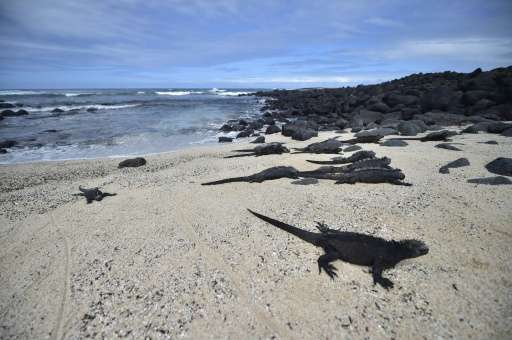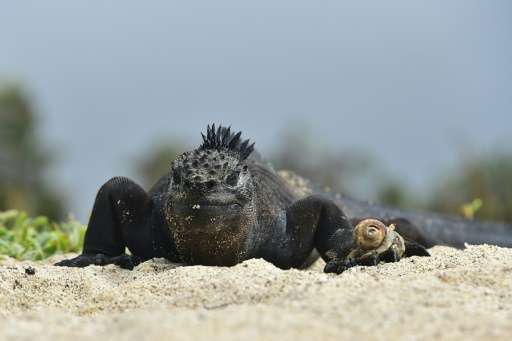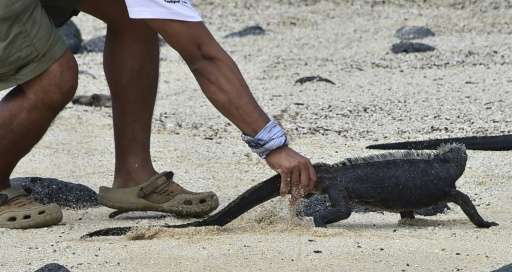Mounting threat to Galapagos from 'El Nino'

The Galapagos Islands, celebrated for their breathtaking biodiversity, could face a major threat from "El Nino," the weather system known to wreak havoc every few years.
The archipelago sustains a vast variety of plant and animal life, and has been recognized as a UNESCO World Heritage Site.
But the fragile Galapagos ecosystem may prove no match for the strong winds, heavy rains and warmer than usual ocean currents that accompany El Nino.
The dangers posed by those climatic changes are particularly acute for marine iguanas—reptiles found only on the Galapagos—which live on land but get their food from the ocean.
"Marine iguanas feed only on algae," Eduardo Espinoza, 46, director of marine research at Galapagos National Park, explained to AFP.
"During times of El Nino, these algae may be scarce and many begin to die," Espinoza said.
"El Nino" refers to the abnormal warming of surface waters in the tropical sections of the Pacific Ocean every three to five years.
Climatologists began observing the most recent El Nino several months ago, and fear that because of global warming, the phenomenon will hit the Galapagos with increasing frequency and greater destructive potential in coming years.
Charles Darwin made the Galapagos famous a century-and-a-half ago with research here that led him to devise his theory of evolution.
Since then, some of the wildlife he studied on the Galapagos already has been wiped out because of man's encroachment, and other species have been put at risk by climate change.

Sharks, birds, iguanas
The Galapagos, one of the world's great protected nature reserves and one of its most sensitive, hosts more endemic species than anywhere else on Earth—from the giant land tortoises that give it its name, to sharks, birds and the marine iguanas.
Espinoza is closely monitoring the impact of the current El Nino on endangered species in the archipelago—especially on marine iguanas, which are particularly sensitive to environmental change in the nature reserve out in the Pacific, some 1,000 kilometers (620 miles) from the Ecuadoran coast.
It's not the first time that wildlife in the Galapagos was ravaged by El Nino.
In 1997 and 1998, El Nino struck with devastating effect in the Galapagos. It wiped out corals, colonies of penguins, sea lions, nests of the flightless marine birds called cormorants—as well as marine iguanas.
Of the iguanas that survived, many experienced severe weight loss, Judith Denkinger, a biologist at the Institute of Ocean Sciences at the University of San Francisco in Quito, told AFP.
It took several years, but the iguana population eventually recovered. Their numbers by 2001 were back up to around 700,000.
The results of a census taken in 2014 will provide updated population figures any day now, scientists here say.

Galapagos on Paris talks agenda
The plight of the Galapagos is expected to be a key agenda item during high-level climate talks in Paris later this year attended by foreign and environment ministers from 45 countries.
Visitors are not allowed to touch the reptiles, but Espinoza freely handles them, lifting them by their tails and sizing them with a yellow tape measure before weighing them to assess the negative effects of the current El Nino.
He says the impact may be prolonged because some expect the weather phenomenon this time to last for several months, possibly through 2016.
The prehistoric-looking marine iguana can live until the age of about 60, scientists said—so long as its environment is not degraded by man-made pollution, climate change and El Nino.
Yet another concern is protecting the sensitive local ecosystem from the eager fingers of tourists seeking souvenirs.
Visitors try to take away sea shells, volcanic rock, even the sand—just this month, an Ecuadoran woman was caught at the airport trying to take 10 kilos (22 pounds) of sand with her.
At the airport, the luggage of departing passengers is scanned as if agents were looking for contraband drugs.
"Tourists act surprised, and tell us this is allowed everywhere else," said Danny Rueda, ecosystem director at the park. "Here, it is not."
© 2015 AFP



















